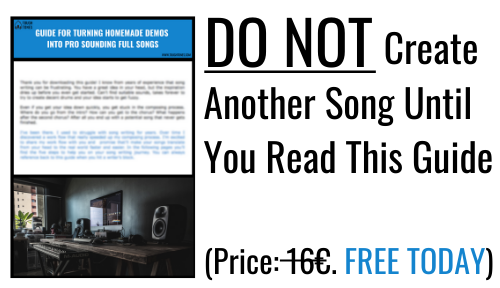Three Song Structures to Learn From
There are certainly many different ways to structure a song, but the main ideas stay the same. Usually songs have two (or more) verses and a couple of choruses, but not a pre-chorus or an intro nearly as frequently as you might think.
Here are three songs and three different song structures for you to compare and to learn from. Maybe you’ve been struggling with forming song structures or your tunes seem to be comprised the same way time after time. So, let’s freshen things up and get some new ideas into your head! Listen through the songs and follow the structures below. Let’s open them up a bit afterwards.
1. Hands Like Houses – Colourblind
- Intro (4 bars effected, 4 bars with band)
- Verse 1 (4 bars without drums, 4 bars with drums)
- Pre-Chorus (8 bars)
- Chorus (8 bars)
- Interlude (same as intro, 4 bars)
- Verse 2 (8 bars)
- Pre-Chorus (8 bars)
- Chorus (8 bars)
- Breakdown/Bridge (8 bars of break, 4 bars of vocals, 4 bars of riff)
- Stripped-Down Chorus (8 bars)
- Chorus (8 Bars)
- Outro (same as intro, 8 bars)
Colourblind is quite straightforward, it starts and ends with the same riff. Then there’s a verse, a pre-chorus, a chorus and the same again separated by the intro riff. After the second chorus comes a breakdown / bridge. Followed by breakdown there’s this mellow, stripped-down chorus which leads to the final full chorus.
2. Biffy Clyro – Biblical
- Verse 1 (8 bars with guitar, 8 bars with the whole band)
- Pre-Chorus (8 bars)
- Chorus (16 bars)
- Post-Chorus (8 bars)
- Verse 2 (8 bars)
- Pre-Chorus (8 bars)
- Chorus (16 bars)
- Post-Chorus (16 bars)
- Bridge (8 bars with choir, 8 bars with choir & vocals)
- Verse (8 bars same as in the beginning of the song)
Biblical kicks off straight from the first verse. Like in Colourblind, this tune has a pre-chorus after each verse as well, but after a chorus comes a post-chorus. In the end there’s a bridge singed by a choir. The song ends exactly the same way and with the same lyrics as it starts – with the verse.
3. Slipknot – Wait And Bleed
- Chorus (8 bars without drums, 8 with drums)
- Interlude (4 bars)
- Verse 1 (16 bars)
- Chorus (8 bars)
- Interlude (2 bars)
- Verse 2 (8 bars)
- Chorus (16 bars)
- Bridge (4 bars without drums, 4 bars with drums, 8 bars with vocals)
- Chorus (16 bars)
- Outro (same as interlude, 8 bars)
Slipknot starts out their song “Wait And Bleed” with a chorus, once without and then once with drums. There’s this short build-up-riff before verses. The same riff is used in the outro too. After the second chorus comes along the bridge and then the final double chorus.

Song Structure
As you study these three songs, you’ll notice the structures follow a certain pattern. All of them have only 4-5 moving parts and that’s it. There’s no sudden weird parts and all the songs flow naturally forward. You don’t want too many sections, as that’ll only confuse the listener. Also avoiding too many parts makes it easier for you to keep the song under control.
Starting a song
The first song starts with an intro, the second with a verse and the third with a chorus. As seen here, you don’t always need an intro. It may be better to start straight from a verse or a chorus. Today the intros are getting shorter and shorter anyway, since we as listeners have become increasingly impatient. Because of the streaming services, listeners change to the next song if they don’t get immediately hooked by the vocals. This is sad, but it seems the long intros are a dying breed.
That being said, I personally think long intros are awesome and we shouldn’t let them go extinct without a fight. In case your song needs an intro, by all means do it, whether it’s long or short. Just make sure it has a point and it’s interesting.
Pre-Chorus & Post-Chorus
Both Colourblind and Biblical contain pre-choruses. Pre-chorus leads listeners to a chorus, it’s sort of a build up. Usually a melody and/or chords and/or lyrics change from a verse and take a different angle. A pre-chorus is an optional section and therefore not needed every time. In Biblical there’s also a post-chorus. As a section, it usually works as a link to the next section and repeats or highlights the important part of the chorus.
How do you know if you need one? Well, for many times you don’t, but for example, if you want to bring out the focal point of your song. Don’t stuff too overcrowding vocals there, maybe just highlight the name or the message you want to say. Kind of like Biffy Clyro does in Biblical.
Bridge / Breakdown
All of these songs have a bridge or a breakdown. That’s quite common and it usually comes after the second chorus or the post-chorus. To me in a breakdown the instrumentation is very stripped and the song sort of calms down. Whereas a bridge is a section that offers contrast compared to other parts. It is used to break the verse – chorus – verse – chorus pattern. I find myself wanting a breakdown if my song is busy otherwise.
Outro
How about outros then? Generally you’ll find them to be the same as the intro or the interlude. Colourblind and Wait And Bleed both have an outro in the end. However in the case of Biblical, there’s a verse, although you could think that the first and the last 8 bars of the song are intro and outro. It depends how you look at it.
I use an outro if I think that my song ends too fast. It’s a way of signalling a listener that the song is nearing to an end. Typically there’s no new material in an outro, as seen in all the three examples in this post.
Summary
Analyzing songs like this can be really helpful. More often than not you get a spark of inspiration by listening what others have done. Also it’s really instructive and will definitely accumulate your musical understanding and knowledge.
Speaking of developing your music skills: download my completely free e-book 5 Steps to Create Music Faster and receive yourself an easy to apply, step by step guide to get more music done without a writer’s block.
Read also: What to Do After the Second Chorus?
